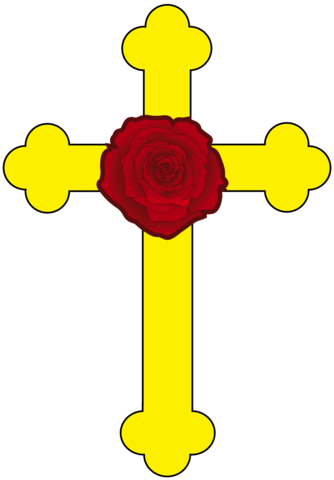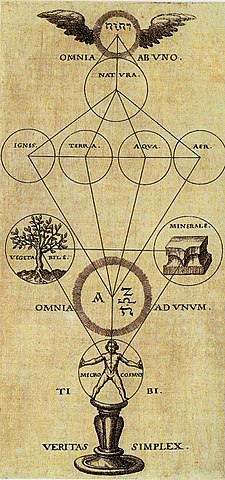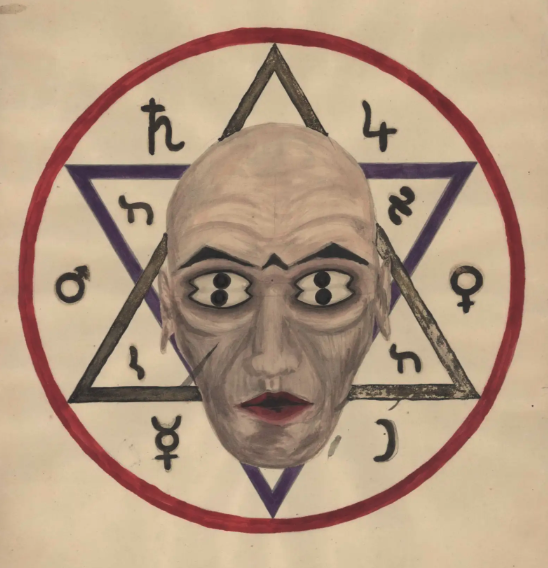Difference between revisions of "Rosicrucian"
Occultwiki (talk | contribs) (Created page with "The '''Rosicrucians''' are a spiritual and cultural movement that arose in Europe in the early 17th century after the publication of several texts announcing to the world a ne...") |
Occultwiki (talk | contribs) |
||
| (2 intermediate revisions by the same user not shown) | |||
| Line 1: | Line 1: | ||
[[File:Rose Cross.png|350px|thumb|Rosy Cross as used by Rosicrucianism]] | |||
The '''Rosicrucians''' are a spiritual and cultural movement that arose in Europe in the early 17th century after the publication of several texts announcing to the world a new esoteric order. Rosicrucianism is symbolized by the Rosy Cross or Rose Cross. | The '''Rosicrucians''' are a spiritual and cultural movement that arose in Europe in the early 17th century after the publication of several texts announcing to the world a new esoteric order. Rosicrucianism is symbolized by the Rosy Cross or Rose Cross. | ||
| Line 4: | Line 5: | ||
==Origin== | ==Origin== | ||
According to the writings of the Masonic historian E.J. Marconis de Negre, the Rosicrucian Order was created in the year 46 when an Alexandrian [[Gnosticism|Gnostic]] sage named Ormus and his six followers were converted by one of [[Jesus Christ|Jesus]]' disciples, Mark. Their symbol was said to be a red cross surmounted by a rose, thus the designation of Rosy Cross. From this conversion, Rosicrucianism was born, by purifying [[Egyptian religion|Egyptian mysteries]] with the new higher teachings of early [[Christianity]]. However, there is no evidence | According to the writings of the Masonic historian E.J. Marconis de Negre, the Rosicrucian Order was created in the year 46 when an Alexandrian [[Gnosticism|Gnostic]] sage named Ormus and his six followers were converted by one of [[Jesus Christ|Jesus]]' disciples, Mark. Their symbol was said to be a red cross surmounted by a rose, thus the designation of Rosy Cross. From this conversion, Rosicrucianism was born, by purifying [[Egyptian religion|Egyptian mysteries]] with the new higher teachings of early [[Christianity]]. However, there is no evidence to support this. | ||
===Convent of Christ in Tomar=== | ===Convent of Christ in Tomar=== | ||
| Line 10: | Line 11: | ||
===Manifestos=== | ===Manifestos=== | ||
[[File:Rosicrucian Concept of the Tree of Pansophia.jpg|350px|thumb|A 17th century depiction of the Rosicrucian concept of the Tree of Pansophia]] | |||
Between 1614 and 1617, three anonymous manifestos were published, first in Germany and soon after throughout Europe: | Between 1614 and 1617, three anonymous manifestos were published, first in Germany and soon after throughout Europe: | ||
* ''Fama Fraternitatis RC'' (''The Fame of the Brotherhood of RC'', 1614) | * ''Fama Fraternitatis RC'' (''The Fame of the Brotherhood of RC'', 1614) | ||
| Line 21: | Line 23: | ||
The three manifestos were, and continue to be, not taken literally by many but rather regarded either as hoaxes or as allegorical statements. They state: "We speak unto you by parables, but would willingly bring you to the right, simple, easy, and ingenuous exposition, understanding, declaration, and knowledge of all secrets." | The three manifestos were, and continue to be, not taken literally by many but rather regarded either as hoaxes or as allegorical statements. They state: "We speak unto you by parables, but would willingly bring you to the right, simple, easy, and ingenuous exposition, understanding, declaration, and knowledge of all secrets." | ||
The first Rosicrucian manifesto was influenced by the work of the respected [[ | The first Rosicrucian manifesto was influenced by the work of the respected [[Hermes Trismegistus|hermetic]] philosopher Heinrich Khunrath, of Hamburg, author of the Amphitheatrum ''Sapientiae Aeternae'' (1609), who was in turn influenced by [[John Dee]], author of the ''Monas Hieroglyphica'' (1564). The writer also claimed the brotherhood possessed a book that resembled the works of [[Paracelsus]]. | ||
==The "Rosicrucian Furor"== | ==The "Rosicrucian Furor"== | ||
| Line 36: | Line 38: | ||
===The Golden and Rosy Cross=== | ===The Golden and Rosy Cross=== | ||
The ''Gold und Rosenkreuzer'' (Golden and Rosy Cross) was founded by the [[alchemy|alchemist]] Samuel Richter who in 1710 published ''Die warhhaffte und vollkommene Bereitung des Philosophischen Steins der Brüderschaft aus dem Orden des Gülden-und Rosen-Creutzes'' (''The True and Complete Preparation of the Philosopher's | The ''Gold und Rosenkreuzer'' (Golden and Rosy Cross) was founded by the [[alchemy|alchemist]] Samuel Richter who in 1710 published ''Die warhhaffte und vollkommene Bereitung des Philosophischen Steins der Brüderschaft aus dem Orden des Gülden-und Rosen-Creutzes'' (''The True and Complete Preparation of the [[Philosopher's stone]] by the Brotherhood from the Order of the Golden and Rosy Cross'') in Breslau under the pseudonym Sincerus Renatus in Prague in the early 18th century as a hierarchical secret society composed of internal circles, recognition signs and alchemy treatises. | ||
Under the leadership of Hermann Fictuld the group reformed itself extensively in 1767 and again in 1777 because of political pressure. Its members claimed that the leaders of the Rosicrucian Order had invented Freemasonry and only they knew the secret meaning of Masonic symbols. They also began circulating claims that the Rosicrucian Order had been founded by an Egyptian named "Ormusse" who had emigrated to Scotland with the name "Builders from the East." In 1785 and 1788 the Golden and Rosy Cross group published the ''Geheime Figuren'' or ''The Secret Symbols of the 16th and 17th century Rosicrucians''. | Under the leadership of Hermann Fictuld the group reformed itself extensively in 1767 and again in 1777 because of political pressure. Its members claimed that the leaders of the Rosicrucian Order had invented Freemasonry and only they knew the secret meaning of Masonic symbols. They also began circulating claims that the Rosicrucian Order had been founded by an Egyptian named "Ormusse" who had emigrated to Scotland with the name "Builders from the East." In 1785 and 1788 the Golden and Rosy Cross group published the ''Geheime Figuren'' or ''The Secret Symbols of the 16th and 17th century Rosicrucians''. | ||
| Line 45: | Line 47: | ||
==Modern era== | ==Modern era== | ||
[[File:Rosicrucian Russian Image.png|400px|thumb|Watercolour painting from the Russian Rosicrucian Order, AMORC (1933)]] | |||
During the late 19th and early 20th centuries, various groups styled themselves Rosicrucian. The diverse groups who link themselves to a "Rosicrucian Tradition" can be divided into three categories: | During the late 19th and early 20th centuries, various groups styled themselves Rosicrucian. The diverse groups who link themselves to a "Rosicrucian Tradition" can be divided into three categories: | ||
| Line 67: | Line 70: | ||
* [https://www.rosicruciansociety.com/ The Rosicrucian Society] | * [https://www.rosicruciansociety.com/ The Rosicrucian Society] | ||
* [http://www.rosicrucian-order.com/mensaje-imperator.html The Rosicrucian Order] | * [http://www.rosicrucian-order.com/mensaje-imperator.html The Rosicrucian Order] | ||
[[Category: Occult Organizations]] | |||
Latest revision as of 17:27, 19 September 2024
The Rosicrucians are a spiritual and cultural movement that arose in Europe in the early 17th century after the publication of several texts announcing to the world a new esoteric order. Rosicrucianism is symbolized by the Rosy Cross or Rose Cross.
In later centuries, many esoteric societies have claimed to derive from the original Rosicrucians. The most influential of these societies has been the Hermetic Order of the Golden Dawn, which derived from Societas Rosicruciana in Anglia and counted many prominent figures among its members. The largest is the Rosicrucian Order, AMORC, a multinational organization based in San Jose, California.
Origin
According to the writings of the Masonic historian E.J. Marconis de Negre, the Rosicrucian Order was created in the year 46 when an Alexandrian Gnostic sage named Ormus and his six followers were converted by one of Jesus' disciples, Mark. Their symbol was said to be a red cross surmounted by a rose, thus the designation of Rosy Cross. From this conversion, Rosicrucianism was born, by purifying Egyptian mysteries with the new higher teachings of early Christianity. However, there is no evidence to support this.
Convent of Christ in Tomar
Around 1530, more than eighty years before the publication of the first manifesto, a minor association of cross and rose existed in Portugal in the Convent of the Order of Christ, home of the Knights Templar, later renamed the Order of Christ. In an interior chamber, the vault contains three bocetes carved in the shape of seven rose-crosses as well as a rosette depicting a circular sun. This room is thought to have been the initiation room because of its initial seven steps and its own underground small chamber or tomb of initiation at the end.
Manifestos
Between 1614 and 1617, three anonymous manifestos were published, first in Germany and soon after throughout Europe:
- Fama Fraternitatis RC (The Fame of the Brotherhood of RC, 1614)
- Confessio Fraternitatis (The Confession of the Brotherhood of RC, 1615)
- Chymical Wedding of Christian Rosicross anno 1459 (1617).
The Fama Fraternitatis presents the legend of a German doctor and mystic philosopher referred to as "Father Brother C.R.C." (later identified in a third manifesto as Christian Rosenkreuz, or "Rose-cross"). The year 1378 is presented as being the birth year of "our Christian Father," and it is stated that he lived 106 years. After studying in the Middle East under various masters, possibly adhering to Sufism, he was unable to spread the knowledge he had acquired to prominent European scientists and philosophers. Instead, he gathered a small circle of friends/disciples and founded the Rosicrucian Order (this can be deduced to have occurred around 1407).
During the lifetime of C.R.C., the order was said to comprise no more than eight members, each a doctor and "all bachelors of vowed virginity." Each member undertook an oath to heal the sick without accepting payment, to maintain a secret fellowship, and to find a replacement for himself before he died. Three such generations had supposedly passed between c. 1500 and c. 1600: a time when scientific, philosophical, and religious freedom had grown so that the public might benefit from the Rosicrucians' knowledge, so that they were now seeking good men.
The three manifestos were, and continue to be, not taken literally by many but rather regarded either as hoaxes or as allegorical statements. They state: "We speak unto you by parables, but would willingly bring you to the right, simple, easy, and ingenuous exposition, understanding, declaration, and knowledge of all secrets."
The first Rosicrucian manifesto was influenced by the work of the respected hermetic philosopher Heinrich Khunrath, of Hamburg, author of the Amphitheatrum Sapientiae Aeternae (1609), who was in turn influenced by John Dee, author of the Monas Hieroglyphica (1564). The writer also claimed the brotherhood possessed a book that resembled the works of Paracelsus.
The "Rosicrucian Furor"
In the early 17th century, the manifestos caused excitement throughout Europe by declaring the existence of a secret brotherhood of alchemists and sages who were preparing to transform the arts and sciences, and religious, political, and intellectual landscapes of Europe. Wars of politics and religion ravaged the continent. The works were re-issued several times, followed by numerous pamphlets, favorable or otherwise. Between 1614 and 1620, about 400 manuscripts and books were published which discussed the Rosicrucian documents.
The peak of the "Rosicrucianism furore" was reached when two mysterious posters appeared on the walls of Paris in 1622 within a few days of each other. The first said "We, the Deputies of the Higher College of the Rose-Croix, do make our stay, visibly and invisibly, in this city (...)", and the second ended with the words "The thoughts attached to the real desire of the seeker will lead us to him and him to us."
Michael Maier was appointed Pfalzgraf (Count Palatine) by Rudolf II, Holy Roman Emperor and King of Hungary and King of Bohemia. He also was one of the most prominent defenders of the Rosicrucians, clearly transmitting details about the "Brothers of the Rose Cross" in his writings. Maier made the firm statement that the Brothers of R.C. exist to advance inspired arts and sciences, including alchemy.
In Freemasonry
The change from "operative" to "speculative" Masonry occurred between the end of the 16th and the beginning of the 18th century. Two of the earliest speculative Masons for whom a record of initiation exists were Sir Robert Moray and Elias Ashmole. Robert Vanloo states that earlier 17th century Rosicrucianism had a considerable influence on Anglo-Saxon Masonry. Hans Schick sees in the works of Comenius (1592–1670) the ideal of the newly born English Masonry before the foundation of the Grand Lodge in 1717. Comenius was in England during 1641.
According to Jean Pierre Bayard, two Rosicrucian-inspired Masonic rites emerged toward the end of 18th century, the Rectified Scottish Rite, widespread in Central Europe where there was a strong presence of the "Golden and Rosy Cross," and the Ancient and Accepted Scottish Rite, first practiced in France, in which the 18th degree is called Knight of the Rose Croix.
The Golden and Rosy Cross
The Gold und Rosenkreuzer (Golden and Rosy Cross) was founded by the alchemist Samuel Richter who in 1710 published Die warhhaffte und vollkommene Bereitung des Philosophischen Steins der Brüderschaft aus dem Orden des Gülden-und Rosen-Creutzes (The True and Complete Preparation of the Philosopher's stone by the Brotherhood from the Order of the Golden and Rosy Cross) in Breslau under the pseudonym Sincerus Renatus in Prague in the early 18th century as a hierarchical secret society composed of internal circles, recognition signs and alchemy treatises.
Under the leadership of Hermann Fictuld the group reformed itself extensively in 1767 and again in 1777 because of political pressure. Its members claimed that the leaders of the Rosicrucian Order had invented Freemasonry and only they knew the secret meaning of Masonic symbols. They also began circulating claims that the Rosicrucian Order had been founded by an Egyptian named "Ormusse" who had emigrated to Scotland with the name "Builders from the East." In 1785 and 1788 the Golden and Rosy Cross group published the Geheime Figuren or The Secret Symbols of the 16th and 17th century Rosicrucians.
Led by Johann Christoph von Wöllner and General Johann Rudolf von Bischoffwerder, the Masonic lodge was infiltrated and came under the influence of the Golden and Rosy Cross causing many Freemasons to become Rosicrucianists. In 1782 at the Convent of Wilhelmsbad the Alte schottische Loge Friedrich zum goldenen Löwen (Old Scottish Lodge Friedrich at the Golden Lion) in Berlin strongly requested Ferdinand, Duke of Brunswick-Lüneburg and all other Freemasons to submit to the Golden and Rosy Cross, without success.
After 1782, this highly secretive society added Egyptian, Greek, and Druidic mysteries to its alchemy system.
Modern era
During the late 19th and early 20th centuries, various groups styled themselves Rosicrucian. The diverse groups who link themselves to a "Rosicrucian Tradition" can be divided into three categories:
- Esoteric Christian Rosicrucian groups, which profess Christ
- Masonic Rosicrucian groups such as Societas Rosicruciana
- Initiatory groups such as the Golden Dawn and the Ancient Mystical Order Rosae Crucis (AMORC).
Many groups generally speak of a linear descent from earlier branches of the ancient Rosicrucian Order in England, France, Egypt, or other countries. However, some groups speak of a spiritual affiliation with a true and invisible Rosicrucian Order.
The Rosicrucian Fellowship
The Rosicrucian Fellowship was created in 1909 at Mount Ecclesia in Oceanside, California. The group's teachings present the mysteries, in the form of esoteric knowledge, of which Christ spoke in Matthew 13:11 and Luke 8:10. The Fellowship seeks to prepare the individual through harmonious development of mind and heart in a spirit of unselfish service to mankind and an all-embracing altruism.
According to the Fellowship, the Rosicrucian Order was founded in 1313 and is composed of twelve exalted Beings gathered around a thirteenth, Christian Rosenkreuz. These great adepts have already advanced far beyond the cycle of rebirth. Their mission is to prepare the whole wide world for a new phase in religion, which includes awareness of the inner worlds and the subtle bodies, and to provide safe guidance in the gradual awakening of man's latent spiritual faculties during the next six centuries toward the coming Age of Aquarius.
In Russia
With the Edict of Toleration of Religion in 1905, several Russians of a mystical mind took advantage of it to form or resurrect what they considered the ancient forms of esoteric Orders. These were the new Rosicrucians.
Their inspired mentors compiled volumes of mystic philosophy, and which they combined with their personal notions of what the ancient Orders were, and so formed groups. The 3 principal neo-Rosicrucian Orders of early Soviet Russia were Emesh Redivivus, the Orionist-Manicheans, and the Lux Astralis. Due to suppression by the Soviets they were eventually disbanded by 1933.


